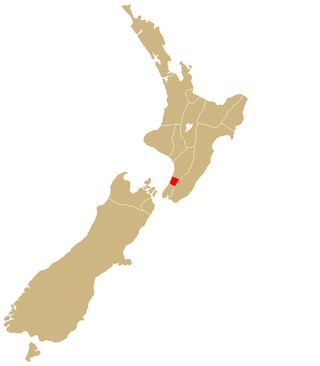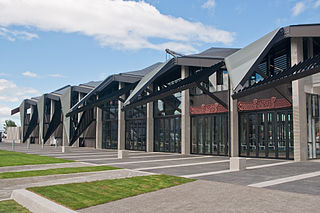
The Hutt Valley campaign was an armed conflict in the lower North Island of New Zealand between indigenous Māori and British settlers and military forces in 1846. The campaign was among the earliest of the 19th century New Zealand Wars that were fought over issues of land and sovereignty. It was preceded by the Wairau affray and followed by the Wanganui campaign and was triggered by much the same pressures—the careless land purchasing practices of the New Zealand Company, armed government support for settler land claims, and complex intertribal tensions between local Māori. The three conflicts also shared many of the same combatants.

Wellington City Council is a territorial authority in New Zealand, governing the city of Wellington, the country's capital city and third-largest city by population, behind Auckland and Christchurch. It consists of the central historic town and certain additional areas within the Wellington metropolitan area, extending as far north as Linden and covering rural areas such as Mākara and Ohariu. The city adjoins Porirua in the north and Hutt City in the north-east. It is one of nine territorial authorities in the Wellington Region.

Berhampore is a suburb of Wellington, New Zealand. It lies towards the south of the city, four kilometres from the city centre, and two kilometres from the coast of Cook Strait. It is surrounded by the suburbs of Vogeltown, Newtown, Melrose, Island Bay, Kingston, and Mornington. The suburb was named after Berhampore in Bengal, one of the battlefields at the start of the Battle of Plassey of 1757. Also surrounding Berhampore is the Berhampore Golf Course as well as a very extensive green belt with many walkways and tracks connecting outlying areas. The suburb also boasts some of Wellington's best all weather sports fields, on Adelaide Road and the national hockey stadium. Alongside the golf course there is a skateboard/bmx park, right by a kids mountain bike track. Berhampore School opened in 1915.

Mount Victoria is a suburb of central Wellington, New Zealand, named after the 196 metres (643 ft) hill Mount Victoria to the east. Mount Victoria's residential area is on its north-western slopes.

Miramar is a suburb of Wellington, New Zealand, south-east of the city centre. It is on the Miramar Peninsula, directly east of the isthmus of Rongotai, the site of Wellington International Airport.

Seatoun is an eastern suburb of Wellington, the capital city of New Zealand and lies on the east coast of the Miramar Peninsula, close to the entrance to Wellington Harbour.

Brooklyn is a suburb of Wellington, the capital city of New Zealand, under the governance of Wellington City Council. It lies 3 km south of Wellington's central business district on the eastern slopes of the hills above Happy Valley. It is located to the south of Aro Valley and Highbury, west of Mount Cook, north of Vogeltown, Mornington and Ōwhiro Bay and east of Kowhai Park, Panorama Heights, Mitcheltown and Karori.

The Aro Valley forms a small inner-city suburb of Wellington in New Zealand. It takes its name from the stream which originally flowed where modern Hōniana Te Puni Street is. The stream's Māori name was originally Wai-Mapihi, but it was commonly called Te Aro Stream due to it running through the Te Aro flat.

Te Aro is an inner-city suburb of Wellington, New Zealand. It comprises the southern part of the central business district including the majority of the city's entertainment district and covers the mostly flat area of city between The Terrace and Cambridge Terrace at the base of Mount Victoria.

Mornington is a suburb of Wellington, New Zealand, on the southern hills behind Brooklyn. It is named after the Duke of Wellington's father, the Earl of Mornington. The original Mornington is in County Meath, and was the Irish seat of the Duke's father. It was named in 1878 from the time when J.F.E. Wright (1827–1891) subdivided his land in the south-west of the city in partnership with Jacob Joseph, and created the suburbs of Mornington and Vogeltown.

Mount Cook is an inner city suburb of New Zealand's capital city of Wellington, The North Island, New Zealand, 1.74km dead south of Wellington's Central Business District. Its local constituency area is the Wellington Central, and is part of the City of Wellington local government area. The suburb stands on the southern fringe of the central city alongside Te Aro and to the north of Newtown.
Vogeltown is a suburb of New Plymouth, in the western North Island of New Zealand. It is located to the southeast of the city centre and east of Frankleigh Park. The suburb was named after Sir Julius Vogel, Prime Minister of New Zealand in the 1870s.

Mākara is a locality located at the western edge of Wellington, New Zealand, close to the shore of the Tasman Sea. The suburb is named after the Mākara Stream.

Muaūpoko is a Māori iwi on the Kāpiti Coast of New Zealand.

The Ngāti Tama is a historic Māori tribe of present-day New Zealand. Their origins, according to Māori oral tradition, date back to Tama Ariki, the chief navigator on the Tokomaru waka. They are located in north Taranaki, around Poutama. River Mōhakatino marks their northern boundary with the Tainui and the Ngāti Maniapoto. The close geographical proximity of Tainui's Ngāti Toa of Kawhia and the Ngati Mutunga explains the long, continuous, and close relationship among these three tribes.
Te Aro was a parliamentary electorate in Wellington, New Zealand from 1881 to 1890. It covered the southern area of the central business district. During the three parliamentary terms of its existence, the electorate was represented by three Members of Parliament.

Te Raukura, otherwise known as Te Wharewaka o Poneke is a building located on Taranaki Street Wharf, Wellington waterfront, New Zealand. It houses a conference venue, Karaka Cafe, and waka house.

Wellington town belt and Outer green belt is a pair of strips of tree-filled wilderness spaces near and around central Wellington, New Zealand's capital city. The inner strip, the town belt, is an elongated U-shape. It was set aside by the city's founders in 1840. It is now about two-thirds of its original area. Portions have been repurposed for various mostly-public purposes, including Wellington Hospital, Victoria University of Wellington, Government House, Wellington Zoo, Wellington College, the Wellington Botanic Garden, and a range of other parks and recreational areas.

Kingston is a southern suburb of Wellington, New Zealand, south of Brooklyn and Mornington. The suburb was developed in the 1960s, when there was more "cut and fill" earthworks in new subdivisions to provide flat sections. In 2013 and 2017 there were slips of unstable land, and a Wellington City Council spokesman blamed the "cut and fill" for the slips, though after a previous slip some local residents suggested that broken or faulty water mains or stormwater drains could be responsible. In 2014 a "slip-prone" Kingston house was demolished. A lot of streets in Kingston have names associated with Canada, such as Vancouver Street and Caribou Place.
Aramoho is a settlement on the Whanganui River, in the Whanganui District and Manawatū-Whanganui region of New Zealand's North Island. It is an outlying suburb of Whanganui.


















